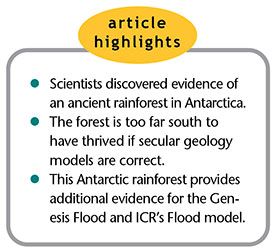 A recent study published in Nature has evolutionary scientists baffled. The researchers reportedly found an ancient rainforest in Antarctica, of all places. The study’s authors claim this part of Antarctica was very close to the South Pole at the time the forest thrived, at about 82° south latitude.1
A recent study published in Nature has evolutionary scientists baffled. The researchers reportedly found an ancient rainforest in Antarctica, of all places. The study’s authors claim this part of Antarctica was very close to the South Pole at the time the forest thrived, at about 82° south latitude.1
How could a temperate rainforest exist this close to the South Pole and survive four-plus months of total darkness each year? A biblical perspective solves this mystery.
Johann Klages of the Alfred Wegener Institute and a consortium of European scientists used a drill ship to take a sediment core off West Antarctica’s Amundsen Sea between February and March 2017.2 The sediments were claimed to be between 84 and 94 million years old, placing them within the Cretaceous system.1 Ashley Strickland of CNN reported:
CT scans of the sediment core revealed pristine samples of forest soil, pollen, spores and even root systems so well preserved that [the researchers] could identify cell structures. The soil included examples of pollen from the first flowering plants found this close to the South Pole.2
Based on these plant fossil types, the scientists determined the area had an average daytime temperature of 53°F, roughly two degrees higher than present-day Germany.1,2 This is much warmer than today’s Antarctic temperatures, which fluctuate between -76 and 14°F.2 Study co-author and Imperial College London professor Tina van de Flierdt told CNN:
The preservation of this 90-million-year-old forest is exceptional, but even more surprising is the world it reveals….Even during months of darkness, swampy temperate rainforests were able to grow close to the South Pole, revealing an even warmer climate than we expected.2
Could forests like this really grow so far south and survive through months of total darkness? It’s highly doubtful, and none of these plant types grow today in polar climates with that little sunlight. What’s going on here?
 Secular scientists have created different plate tectonic configurations that they believe existed throughout the deep time required by their evolutionary worldview. During the Cretaceous, they place this part of Antarctica close to the South Pole. The plants reported in the study would thus have grown in this extreme southerly position. But in a global Flood model, these plants grew only about 4,400 years ago on land that was much farther north.
Secular scientists have created different plate tectonic configurations that they believe existed throughout the deep time required by their evolutionary worldview. During the Cretaceous, they place this part of Antarctica close to the South Pole. The plants reported in the study would thus have grown in this extreme southerly position. But in a global Flood model, these plants grew only about 4,400 years ago on land that was much farther north.
Most creation geologists believe the tectonic plates moved rapidly during the Flood year.3 The Flood model we’ve developed at ICR holds that Antarctica was part of a Pangaea-like supercontinent when these fossils plants were growing.4 They were buried late in the Flood as the waters were nearing their zenith. In fact, our pre-Flood continental configuration has the Antarctic plant fossils growing near 45° south latitude, about the equivalent to southern New Zealand.4 Not surprisingly, these types of trees and flowering plants are exactly the types we find in that area today. As Ashley Strickland reported, “The forests were similar to those now found on New Zealand’s South Island, the researchers said.”2
The baffling discovery of a lush rainforest near the South Pole isn’t a mystery if the book of Genesis is viewed as an accurate historical record. These trees and plants grew in a temperate climate far from the South Pole and were buried, fossilized, and rapidly moved to their present position during the Flood year just 4,400 years ago. These fossils bear strong testimony to the accuracy of the Genesis narrative.
References
- Klages, J. P. et al. 2020. Temperate rainforests near the South Pole during peak Cretaceous warmth. Nature. 580: 81-86.
- Strickland, A. Evidence of ancient rainforests found in Antarctica. CNN. Posted on cnn.com April 1, 2020, accessed April 2, 2020.
- Clarey, T. 2016. Embracing Catastrophic Plate Tectonics. Acts & Facts. 45 (5): 8-11.
- Clarey, T. 2020. Carved in Stone: Geological Evidence of the Worldwide Flood. Dallas, TX: Institute for Creation Research, 153-179.
* Dr. Clarey is Research Associate at the Institute for Creation Research and earned his Ph.D. in geology from Western Michigan University.





